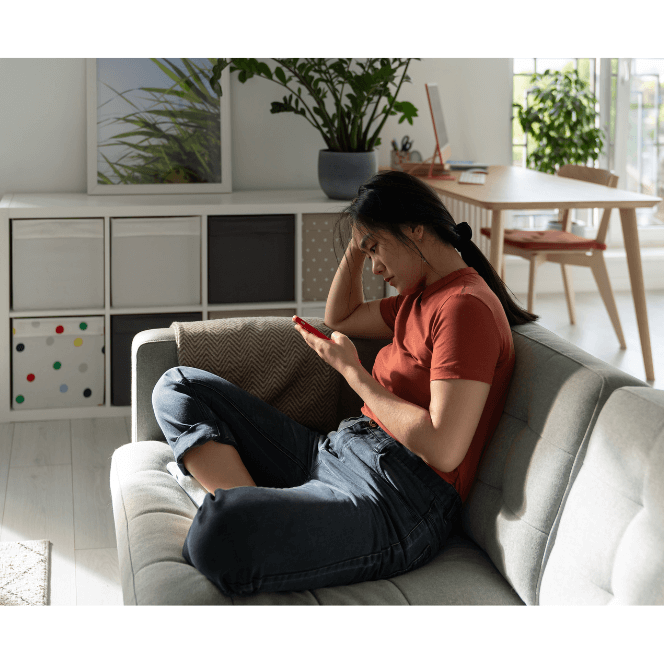Keeping in touch via video, phone and instant messaging was little help in preventing a rise in people’s anxiety and depression during the pandemic lockdowns, a major new UK study has found.
Many young people who increased their use of video and messaging with friends and family who they couldn’t see face-to-face experienced a deterioration in their mental health, the research says.
Dr Patrick Rouxel and Professor Tarani Chandola, of the University of Hong Kong, analysed data on more than 16,000 people’s internet use, mental health and social isolation from four British surveys carried out during lockdowns in 2020 and 2021. They found that:
- People who used video or phones every day to keep in touch with family and friends outside their household were only 3% lower on a scale for anxiety-depression than those who never did.
- People who using internet messaging services such as Facebook, Twitter and WhatsApp every day during the lockdowns had an anxiety-depression score the same as those who never used them.
- People aged 20 who used social media infrequently before the pandemic were 10% higher on the anxiety-depression scale if they used it every day during lockdown, compared to their peers who used it 2-3 times a week during lockdown.
“Early on in the pandemic, several commentators suggested that online communication modes and video technology in particular can bridge social distances during the pandemic,” the researchers say in an article in Sociology journal, published today [Wednesday 24 May 2023] by the British Sociological Association.
“We found little evidence to support the idea that online modes of social contact could compensate for the restrictions in in-person social contact during the pandemic.
“The reduction in mental health associated with reduced in-person social contact during the pandemic was not offset by online or telephone modes of social contact.
“Young adults who increased their online social media frequency during the pandemic experienced a deterioration in mental health. Young adulthood is a sensitive period of the life-course for social relationships, with increases in online social media frequency during the pandemic having adverse effects on mental health.”
The research also found that people whose finances had worsened during lockdown had an anxiety-depression level a quarter higher than those who did not.
The researchers used data gathered by: the Millennium Cohort Study of people born between 2000 and 2002; Next Steps, on those born 1989–1990; the British Cohort Study, on those born in 1970; and the National Child Development Study, on those born in 1958. All the surveys asked about anxiety and depression.
The survey covered the periods of May 2020, during the first lockdown; September and October 2020, when restrictions were lifted in many places; and February and March 2021, during the third lockdown.
- Dr Patrick Rouxel is a postdoctoral researcher based in the Faculty of Social Sciences at the University of Hong Kong. Tarani Chandola is Professor of Medical Sociology in the Department of Sociology, University of Hong Kong. He was previously the head of the Department of Social Statistics and the Director of the Cathie Marsh Institute for Social Research at the University of Manchester.
For more information, please contact:
Tony Trueman
British Sociological Association
Tel: 0044 (0)7964 023392
tony.trueman@britsoc.org.uk
Notes:
- As the surveys did not begin until May 2020 the research does not measure the initial overall increase in anxiety-depression when the first lockdown began in March. However, people’s reaction to subsequent lockdowns, and to the ending of the first and second lockdowns, could be measured. The researchers found that, overall, people who had to switch from meeting friends and family outside the home to keeping in touch online experienced up to 5% increase in their anxiety-depression score.
- The researchers created a scale of anxiety and depression by combining responses to questions from the Generalised Anxiety Disorder 2-item and the Patient Health Questionnaire 2-item. The GAD-2 is a screening tool for generalised anxiety disorder with questions on ‘feeling nervous, anxious or on edge’ and ‘not being able to stop or control worrying’ over the previous two weeks. The PHQ-2 enquires about the frequency of depressed mood and anhedonia with questions on ‘little interest or pleasure in doing things’ and ‘feeling down, depressed or hopeless’ over the previous two weeks. Responses for both the GAD-2 and the PHQ-2 ranged from 1 (not at all), 2 (several days), 3 (more than half the days) and 4 (nearly every day). The mean of the four items at each wave was generated with a range from 1 to 4 with higher values indicating greater anxiety and depression. The researchers also used the Kessler scale, a quantifier of non-specific psychological distress (only available in the MCS cohort). It consists of six questions about depressive and anxiety symptoms that a person has experienced in the last 30 days. Responses ranged from 1 (all of the time) to 5 (none of the time). The mean of the six items at each wave was generated with a range from 1 to 5 with higher values indicating greater psychological distress.
- The paper is entitled ‘No substitute for in-person interaction: changing modes of social contact during the coronavirus pandemic and effects on the mental health of adults in the UK’ in Sociology journal, published by the British Sociological Association and SAGE. The BSA’s charitable aim is to promote sociology. It is a company limited by guarantee, registered in England and Wales. Company Number: 3890729. Registered Charity Number 1080235 www.britsoc.co.uk


